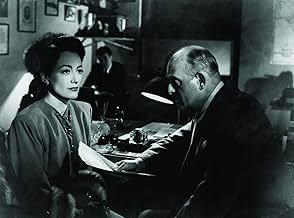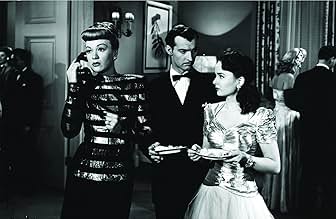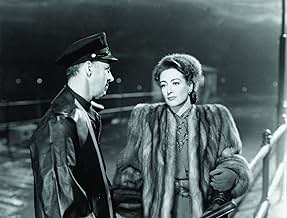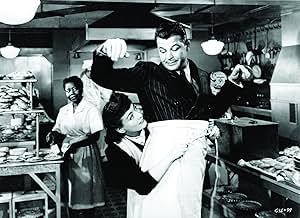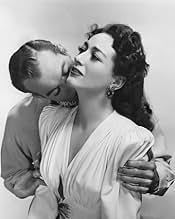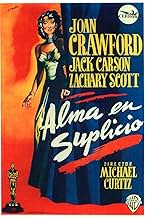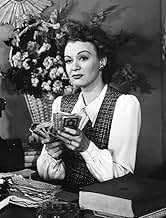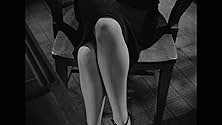Eine hart arbeitende Mutter steuert auf eine Katastrophe zu, als sie sich von ihrem Ehemann scheiden lässt und ein erfolgreiches Restaurant eröffnet, um ihre verwöhnte Tochter zu unterstütze... Alles lesenEine hart arbeitende Mutter steuert auf eine Katastrophe zu, als sie sich von ihrem Ehemann scheiden lässt und ein erfolgreiches Restaurant eröffnet, um ihre verwöhnte Tochter zu unterstützen.Eine hart arbeitende Mutter steuert auf eine Katastrophe zu, als sie sich von ihrem Ehemann scheiden lässt und ein erfolgreiches Restaurant eröffnet, um ihre verwöhnte Tochter zu unterstützen.
- 1 Oscar gewonnen
- 3 Gewinne & 7 Nominierungen insgesamt
Bill Alcorn
- Soldier
- (Nicht genannt)
Betty Alexander
- Party Guest
- (Nicht genannt)
Ramsay Ames
- Party Guest
- (Nicht genannt)
George Anderson
- Peterson's Assistant
- (Nicht genannt)
James Anderson
- Diner Customer
- (Nicht genannt)
Robert Arthur
- High School Boy
- (Nicht genannt)
Lynn Baggett
- Waitress
- (Nicht genannt)
Leah Baird
- Police Matron
- (Nicht genannt)
Zusammenfassung
Reviewers say 'Mildred Pierce' is acclaimed for its strong female lead, complex dynamics, and themes of maternal love and social class. Joan Crawford's Oscar-winning performance is celebrated, and the film's noir elements are noted. However, some find the pacing slow and melodrama excessive, with Veda's character criticized. Despite this, it's seen as a classic with significant historical portrayal of women's roles.
Empfohlene Bewertungen
James M Cain's novel 'Mildred Pierce' was much tougher, dirtier, violent and cynical than the gorgeously mounted movie it became, but the film still manages to maintain enough of the flavor of the book to be interesting. The portrait of working class life in Southern California works well, as does the depiction of a marriage that breaks down because of disappointment and resentment rather than anything melodramatic. Within its first hour MILDRED PIERCE captures something anxious about American life and marriages and families that is more true than most of what movies had shown up to that time, and it would prove to be even more so in the postwar world to come. The movie actually becomes more false and synthetic as it moves into Mildred's rise in life, but by then the plot and characters have taken hold.
And so has the film's increasingly bleak look at what women can expect when they live and work alone in a man's world, beset by men who want to exploit them, sexually and otherwise. This too, though softened from the book, would have seemed refreshingly frank to many of viewers at that time.
What raises the film to the level of classic is the first class work from every professional in every department. Joan Crawford is not much more expressive here than she was in her later MGM pictures, but this character suits her limited talents so well that she seems better than in almost anything else she did. All her Warners pictures used her more effectively than MGM usually managed to do, perhaps because in them she is invariably exploited, abused, maligned, even tortured. The bad behavior her Warners characters inspire in others is so extreme that she doesn't need to be. These plots do what Adrian's sometimes garish clothes did for her at MGM: they give her a personality, make her seem more interesting than she really was, and they make her sympathetic despite her essential coldness. Crawford gets able support from Ann Blyth, Eve Arden (as comedy relief; she is almost appearing in another movie entirely), Zachary Scott and especially Jack Carson, dead-on as a sweaty hustler and low rent lothario, bringing nuance to what could have been a one-note portrayal. Bruce Bennett isn't really a good actor in the role of Mildred's first husband, but he's perfectly cast -- he looks like an Okie from one of Dorothea Lange's photographs who went west to 'make it' and never did.
And as has been frequently mentioned here, Ernest Haller's cinematography (especially in the brilliant prints now being shown on cable) is consistently evocative and beautiful. So many of his shots live in the memory: in the scene where a mink wearing, gun wielding Mildred comes upon Monte and Vida kissing, the image is an almost primal one of betrayal and glamor -- the way their profiles are in darkness, the way Ann Blyth arches back against the bar, the hard, dim glitter of lame and the billows of tulle from her gown. The way Vida tumbles forward into almost blinding lamplight while Monte's face hardens behind her -- these are the kinds of wonderful images the best old films regularly delivered. Also excellent is Anton Grot's art direction, opulent but still managing to help create the particular SoCal atmosphere of this picture. And as usual, Max Steiner's score is effective, but as an earlier poster noted, he recycled a couple of motifs from his Oscar-winning score to NOW, VOYAGER. And director Michael Curtiz must be praised for keeping everything in perfect balance. This is one of the most admired '40s pictures and well worth a look.
And so has the film's increasingly bleak look at what women can expect when they live and work alone in a man's world, beset by men who want to exploit them, sexually and otherwise. This too, though softened from the book, would have seemed refreshingly frank to many of viewers at that time.
What raises the film to the level of classic is the first class work from every professional in every department. Joan Crawford is not much more expressive here than she was in her later MGM pictures, but this character suits her limited talents so well that she seems better than in almost anything else she did. All her Warners pictures used her more effectively than MGM usually managed to do, perhaps because in them she is invariably exploited, abused, maligned, even tortured. The bad behavior her Warners characters inspire in others is so extreme that she doesn't need to be. These plots do what Adrian's sometimes garish clothes did for her at MGM: they give her a personality, make her seem more interesting than she really was, and they make her sympathetic despite her essential coldness. Crawford gets able support from Ann Blyth, Eve Arden (as comedy relief; she is almost appearing in another movie entirely), Zachary Scott and especially Jack Carson, dead-on as a sweaty hustler and low rent lothario, bringing nuance to what could have been a one-note portrayal. Bruce Bennett isn't really a good actor in the role of Mildred's first husband, but he's perfectly cast -- he looks like an Okie from one of Dorothea Lange's photographs who went west to 'make it' and never did.
And as has been frequently mentioned here, Ernest Haller's cinematography (especially in the brilliant prints now being shown on cable) is consistently evocative and beautiful. So many of his shots live in the memory: in the scene where a mink wearing, gun wielding Mildred comes upon Monte and Vida kissing, the image is an almost primal one of betrayal and glamor -- the way their profiles are in darkness, the way Ann Blyth arches back against the bar, the hard, dim glitter of lame and the billows of tulle from her gown. The way Vida tumbles forward into almost blinding lamplight while Monte's face hardens behind her -- these are the kinds of wonderful images the best old films regularly delivered. Also excellent is Anton Grot's art direction, opulent but still managing to help create the particular SoCal atmosphere of this picture. And as usual, Max Steiner's score is effective, but as an earlier poster noted, he recycled a couple of motifs from his Oscar-winning score to NOW, VOYAGER. And director Michael Curtiz must be praised for keeping everything in perfect balance. This is one of the most admired '40s pictures and well worth a look.
The characterization of film noire is applied to certain films that touch on the grittier, more cynical aspects of life. This genre is typified as having lead roles played by strong, solemn male characters, in this respect, Mildred Pierce is an exception. In all other ways Mildred Pierce follows the model for a great film noire. The main character encounters both success and crushing emotional hardships, which the viewer gets to see the effects of. The supporting characters do a wonderful job depicting deceit in action, and each individual character contributes moving specific parts of the film along. The film ends with somewhat of an untied knot, and the viewer could certainly learn to love Mildred as the epitome of a "tragic hero". The film starts with a mystery and works it's way backwards, and as you can assume the viewer imagines he/she knows what is going on, when clearly the writer has us at his whims. Great acting. Great tragedy. Great film noire.
The story that unfolds in Mildred Pierce is complicated and dark, and at its darkest, is a chilling portrait of a mother so devoted to her children (well, child, really) that she would go to any and all lengths for them. Although some of the situations and scenes suffer from the passage of time (the modern audience in the cinema, myself included, couldn't help laughing at some of the more ludicrous things said/done), the film as a whole worked, mostly on the strength of the performances.
Joan Crawford won her only Oscar for her role, and it was well-deserved--she held the film together with a confident performance that ranged from charming and sassy, to desperate and almost frightening. The final scenes of the film, especially, captured Mildred at her most pathetic, and Crawford looked utterly despondent in the telephone scene. Ann Blyth is utterly convincing as the spoilt, deeply disturbed Veda, narcissistic and unrelentingly manipulative of her mother. And the best supporting performance had to come from Eve Arden, who played Mildred's friend Ida--Arden saunters across the screen, stealing scenes left and right, before disappearing from view again. She was excellent!
The film is well worth the watch--not brilliant, but definitely very good. I also like the story-telling technique and the direction (the director made quite clever and frequent use of shadows and mirrors), and it's good that the darkness and melodrama was frequently mitigated by the well-written dialogue. 8/10.
Joan Crawford won her only Oscar for her role, and it was well-deserved--she held the film together with a confident performance that ranged from charming and sassy, to desperate and almost frightening. The final scenes of the film, especially, captured Mildred at her most pathetic, and Crawford looked utterly despondent in the telephone scene. Ann Blyth is utterly convincing as the spoilt, deeply disturbed Veda, narcissistic and unrelentingly manipulative of her mother. And the best supporting performance had to come from Eve Arden, who played Mildred's friend Ida--Arden saunters across the screen, stealing scenes left and right, before disappearing from view again. She was excellent!
The film is well worth the watch--not brilliant, but definitely very good. I also like the story-telling technique and the direction (the director made quite clever and frequent use of shadows and mirrors), and it's good that the darkness and melodrama was frequently mitigated by the well-written dialogue. 8/10.
Joan Crawford, one of the world's great movie stars, truly shines in "Mildred Pierce", a tense, prickly film noir full of suspense and drama!
Joan is Mildred, a hard working pie and chicken maven who becomes a successful restuaranteur. Ann Blyth is superb as her nasty daughter Veda, who stoops to every level to get what she wants. Eve Arden and Jack Carson are unstoppable as Mildred's friends. "Mildred Pierce" was directed by the famed Michael Curtiz, best known for his work in "Casablanca". But it is my opinion that his best work is "Mildred Pierce". The lighting, the costumes, the sets, and most importantly, the writing all help this gem of a film become a true classic.
Joan won an Oscar for her breathtaking performance, but the tour de force powerhouse in "Mildred Pierce" was Ann Blyth. Black hearted Veda was the lynch pin of this movie, and Blyth's portrayal made Veda seem all too real and frightening. Nominated for an Oscar, she should have won.
Don't miss this timeless nail-biter
Joan is Mildred, a hard working pie and chicken maven who becomes a successful restuaranteur. Ann Blyth is superb as her nasty daughter Veda, who stoops to every level to get what she wants. Eve Arden and Jack Carson are unstoppable as Mildred's friends. "Mildred Pierce" was directed by the famed Michael Curtiz, best known for his work in "Casablanca". But it is my opinion that his best work is "Mildred Pierce". The lighting, the costumes, the sets, and most importantly, the writing all help this gem of a film become a true classic.
Joan won an Oscar for her breathtaking performance, but the tour de force powerhouse in "Mildred Pierce" was Ann Blyth. Black hearted Veda was the lynch pin of this movie, and Blyth's portrayal made Veda seem all too real and frightening. Nominated for an Oscar, she should have won.
Don't miss this timeless nail-biter
Mildred Pierce is directed by Michael Curtiz and adapted from the James M. Cain novel by Ranald MacDougall, William Faulkner and Catherine Turney. It stars Joan Crawford, Ann Blyth, Jack Carson, Zachary Scott, Bruce Bennett and Eve Arden. Music is by Max Steiner and the cinematographer is Ernest Haller. It was nominated for 6 Academy Awards and won just the one for Crawford in the Best Actress category.
Plot finds Crawford as Mildred Pierce, a devoted Mother of two girls who struggles to not only make her marriage work, but to also keep her eldest daughter, Veda (Blyth), in the luxurious life she demands. Murder, treachery and heartache is about to dog the Pierce family.
This is of course the film that is often remembered for being the film that saved Joan Crawford's career. After being dumped by MGM, and tagged with being box office poison, Crawford, it seemed, was destined to be the latest visitor to the acting scrap heap. But Jerry Wald over at Warner Brothers had other ideas. The part of Mildred had been offered to some of the big hitting ladies on the Warner studio lot, Stanwyck, Davies and Sheridan are just three of the names known to have shied away from the role. The feeling was that playing a woman with a mid-teen daughter was a no go for the age proud ladies. But Crawford, just entering her forties, took the role on, and in spite of initial protestations from director Curtiz, gave a terrific performance that landed her the coveted golden statuette and prolonged her film career for another 25 years.
Blending the psychological aspects of the woman's picture with the physical edges of film noir, "Mildred Pierce" is something of a unique picture. Very popular on release (it was a box office smash), it was thought that Cain's source novel wouldn't transfer well to the screen. Credit then to the writers for managing to create such an intriguing and watchable piece. True, they have had to tone down aspects from the book, and even added incidents and changed characters, but the essence is right and the timing couldn't have been more perfect for such a story. As film noir was becoming a telling style of film making, the pic also coincided with the later stages of WWII - a time when the role of the Woman, either in the service or at home, was under scrutiny. One of the great things about the film, and the performance of Crawford, is that it cobbles together many character strands of the 40s woman - in life and in film noir. She's a Suzy homemaker type, asked to be mother and wife, yet driven to be a business woman because she feels she's lacking in the necessary family home department. Where the film gets its noir flecks from is that Mildred may also be a murderer, a femme fatale, a woman whose every decision spells trouble. It's as if the makers (not just here but many others at the time) are saying that a woman's place is in the home, doing homely family stuff. Intriguing for sure, not necessarily in good taste, but an added spice into the melodramatic cooking pot that already contains greed and obsession.
Told with a flashback structure, the film is smoothly directed by the versatile Curtiz. But both he and Crawford are aided considerably across the board, not least by a truly great "Bitch" performance from Blyth. Veda is at one detestable, spoilt and mean, the daughter from hell, a status-seeking brat whose love comes at enormous cost to those who dare to get close to her. Blyth revels in it and her play off with Crawford is one of the film's major strengths. The support cast of Scott, Carson, Arden and Bennett are excellent value, while Steiner's music is unobtrusive and able to shift freely with the narrative twists. Finally it's left to Hallers photography to capture the feel and mood of the unfolding story. Shifting from sunny suburbia one moment to shadowy expressionistic bleakness the next, the photographer of such notable film's like "Gone With the Wind" and "Rebel Without a Cause", is integral to the moody excellence of "Mildred Pierce".
A murder mystery flanked by asides of class distinction, bad parenting, dubious sexual leanings and pure greed. Yep, "Mildred Pierce" is no ordinary movie - and hooray for that. 8.5/10
Plot finds Crawford as Mildred Pierce, a devoted Mother of two girls who struggles to not only make her marriage work, but to also keep her eldest daughter, Veda (Blyth), in the luxurious life she demands. Murder, treachery and heartache is about to dog the Pierce family.
This is of course the film that is often remembered for being the film that saved Joan Crawford's career. After being dumped by MGM, and tagged with being box office poison, Crawford, it seemed, was destined to be the latest visitor to the acting scrap heap. But Jerry Wald over at Warner Brothers had other ideas. The part of Mildred had been offered to some of the big hitting ladies on the Warner studio lot, Stanwyck, Davies and Sheridan are just three of the names known to have shied away from the role. The feeling was that playing a woman with a mid-teen daughter was a no go for the age proud ladies. But Crawford, just entering her forties, took the role on, and in spite of initial protestations from director Curtiz, gave a terrific performance that landed her the coveted golden statuette and prolonged her film career for another 25 years.
Blending the psychological aspects of the woman's picture with the physical edges of film noir, "Mildred Pierce" is something of a unique picture. Very popular on release (it was a box office smash), it was thought that Cain's source novel wouldn't transfer well to the screen. Credit then to the writers for managing to create such an intriguing and watchable piece. True, they have had to tone down aspects from the book, and even added incidents and changed characters, but the essence is right and the timing couldn't have been more perfect for such a story. As film noir was becoming a telling style of film making, the pic also coincided with the later stages of WWII - a time when the role of the Woman, either in the service or at home, was under scrutiny. One of the great things about the film, and the performance of Crawford, is that it cobbles together many character strands of the 40s woman - in life and in film noir. She's a Suzy homemaker type, asked to be mother and wife, yet driven to be a business woman because she feels she's lacking in the necessary family home department. Where the film gets its noir flecks from is that Mildred may also be a murderer, a femme fatale, a woman whose every decision spells trouble. It's as if the makers (not just here but many others at the time) are saying that a woman's place is in the home, doing homely family stuff. Intriguing for sure, not necessarily in good taste, but an added spice into the melodramatic cooking pot that already contains greed and obsession.
Told with a flashback structure, the film is smoothly directed by the versatile Curtiz. But both he and Crawford are aided considerably across the board, not least by a truly great "Bitch" performance from Blyth. Veda is at one detestable, spoilt and mean, the daughter from hell, a status-seeking brat whose love comes at enormous cost to those who dare to get close to her. Blyth revels in it and her play off with Crawford is one of the film's major strengths. The support cast of Scott, Carson, Arden and Bennett are excellent value, while Steiner's music is unobtrusive and able to shift freely with the narrative twists. Finally it's left to Hallers photography to capture the feel and mood of the unfolding story. Shifting from sunny suburbia one moment to shadowy expressionistic bleakness the next, the photographer of such notable film's like "Gone With the Wind" and "Rebel Without a Cause", is integral to the moody excellence of "Mildred Pierce".
A murder mystery flanked by asides of class distinction, bad parenting, dubious sexual leanings and pure greed. Yep, "Mildred Pierce" is no ordinary movie - and hooray for that. 8.5/10
Wusstest du schon
- WissenswertesAfter seeing the film, James M. Cain sent Joan Crawford a signed first edition of the original novel. The inscription read: "To Joan Crawford, who brought Mildred Pierce to life just as I had always hoped she would be, and who has my lifelong gratitude."
- PatzerMildred's house on Corvallis Street in Glendale is shown as a one-story Spanish-style bungalow; however, the interior has a staircase leading to the bedrooms.
- Zitate
Ida Corwin: [to Wally about his lustful looks in her direction] Leave something on me. I might catch cold.
- Crazy CreditsThe opening credits are presented with a background ocean scene that "washes" the credits on the screen.
- Alternative VersionenAlso shown in computer colorized version.
- VerbindungenFeatured in Hollywoods goldene Jahre, Teil 2: Die große Zeit des Tonfilms (1962)
- SoundtracksYou Must Have Been a Beautiful Baby
(uncredited)
Music by Harry Warren
Lyrics by Johnny Mercer
Played and sung at Wally's club toward the beginning
Also played when Veda and Ted are at Wally's club
Top-Auswahl
Melde dich zum Bewerten an und greife auf die Watchlist für personalisierte Empfehlungen zu.
- How long is Mildred Pierce?Powered by Alexa
Details
Box Office
- Budget
- 1.453.000 $ (geschätzt)
- Weltweiter Bruttoertrag
- 11.751 $
- Laufzeit1 Stunde 51 Minuten
- Farbe
- Seitenverhältnis
- 1.37 : 1
Zu dieser Seite beitragen
Bearbeitung vorschlagen oder fehlenden Inhalt hinzufügen

Oberste Lücke
What is the streaming release date of Solange ein Herz schlägt (1945) in Brazil?
Antwort



